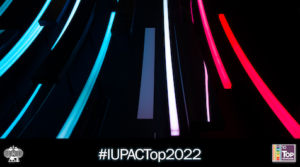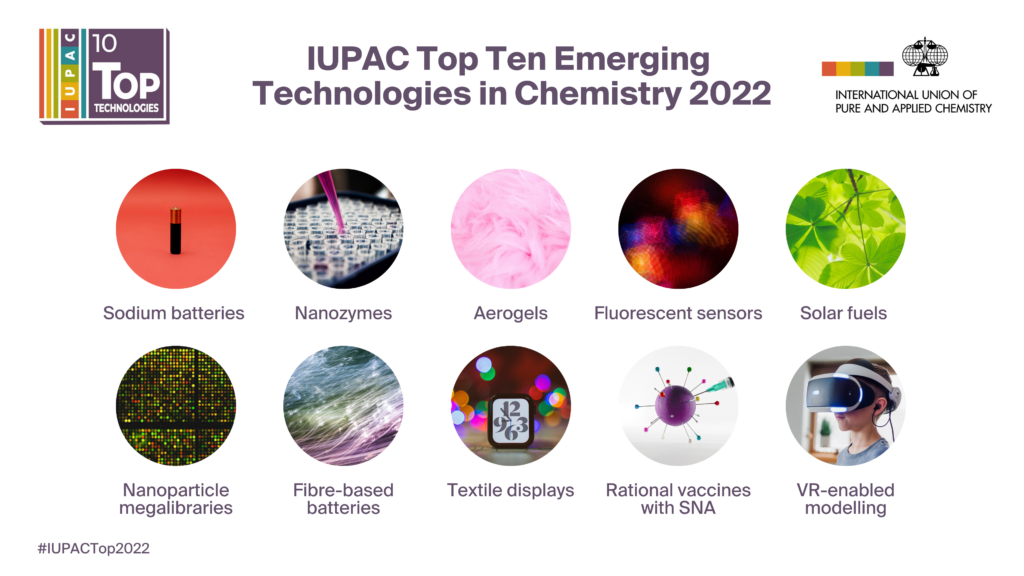The International Union of Pure and Applied Chemistry (IUPAC) has released the 2022 Top Ten Emerging Technologies in Chemistry. The goal of this initiative is to showcase the transformative value of chemistry and to inform the general public about the potential of chemical sciences to foster the well-being of Society and the sustainability of our planet. The Jury* –an international panel of prestigious scientists with a varied and broad range of expertise– reviewed and discussed the diverse pool of nominations of emerging technologies submitted by researchers from around the globe and selected the final top ten. These technologies are defined as transformative innovations in between a discovery and a fully-commercialized technology, having outstanding potential to open new opportunities in chemistry, sustainability, and beyond.
 The 2022 finalists are (in alphabetical order):
The 2022 finalists are (in alphabetical order):
- Aerogels
- Fibre batteries
- Film-based fluorescent sensors
- Liquid solar fuel synthesis
- Nanoparticle mega libraries
- Nanozymes
- Rational vaccines with SNA
- Sodium-ion batteries
- Textile displays
- VR-enable interactive modeling
IUPAC President, Professor Javier García Martínez, said that “the role of chemistry is central to finding and implementing innovative solutions that enable a more sustainable future. With this initiative, IUPAC informs policy and industry leaders, granting agencies, and the general public about technologies that are already creating new opportunities and opening new avenues for research and industry. The importance of this initiative is emphasized by the generous sponsorship of the International Year of Basic Sciences for Sustainable Development (IYBSSD-2022) and the Federacíon Empresarial de la Industria Química Española (feiQue) for which IUPAC is deeply grateful.”
The 2022 Top Ten Emerging Technologies in Chemistry are further detailed in a feature article published in the October issue of Chemistry International (CI). Fernando Gomollón-Bel, the author has said, “This project, recognized by experts worldwide, highlights the value of the chemical sciences in the transition to a green economy and a more sustainable world, in line with the United Nations’ Sustainable Development Goals (SDGs). This year IUPAC joins the celebration of the International Year of Basic Sciences for Sustainable Development (IYBSSD), a UN resolution to reaffirm and emphasize the importance of basic sciences, chemistry among them, to attain the ambitious SDGs by 2030. Each of the technologies gives us a glimpse of what chemistry can achieve and how creativity and commitment for a more sustainable future can yield the solutions we so urgently need.” The article is freely-available from the Chem Int Oct 2022 issue or <iupac.org/what-we-do/top-ten/>.
The first selection of the Top Ten Emerging Technologies in Chemistry was released in 2019 as a special activity honoring IUPAC’s 100th anniversary. The results were published in the April 2019 issue of Chemistry International, 41(2), pp. 12-17, 2019; https://doi.org/10.1515/ci-2019-0203). The results of subsequent editions and the related articles in CI can be accessed at iupac.org/what-we-do/top-ten/.
The search for the 2023 Top Ten Emerging Technologies in Chemistry has already begun and is being led again by Michael Droescher, Treasurer and General Secretary of the German Association for the Advancement of Science and Medicine. Prof. Droescher served as a judge for the initial search and has been chair of the Jury since 2020. Link here for more information on the search for the 2023 Top Ten Emerging Technologies in Chemistry.
*The following comprised the panel of judges for the 2022 Top Ten Emerging Technologies in Chemistry: Chair, Michael Droescher, (German Association for the Advancement of Science and Medicine), Jorge Alegre-Cebollada (Centro Nacional de Investigaciones Cardiovasculares, Spain), Christine Luscombe (Okinawa Institute of Science and Technology, Japan), Javier García Martínez (Universidad de Alicante, Spain), Ehud Keinan (Technion, Israel), Rai Kookana (CSIRO Land & Water, Australia), Zhigang Shuai (Tsinghua University, China), Natalia P. Tarasova (D. I. Mendeleev University of Chemical Technology, Russia), and Bernard West (Life Sciences Ontario, Canada).

About IUPAC: Founded in1919 by academic and industrial chemists as a neutral and objective scientific organization, the International Union of Pure and Applied Chemistry (IUPAC) is the world authority on chemical nomenclature and terminology, including the naming of new elements in the periodic table; on standardized methods for measurement; and on atomic weights, and many other critically-evaluated data. It was founded with the goal of uniting a fragmented, global chemistry community in order to advance the chemical sciences through collaborative efforts and the free exchange of scientific information. For more than a century IUPAC has fulfilled that goal through the creation of a common language, the standardization of processes and procedures and many diverse and global activities that ultimately impact both the chemical profession and Society as a whole. For more information on IUPAC go to: https://iupac.org/.
